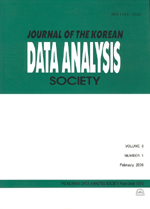중소기업 신용평가를 위한 MEU모형 적용연구
A Study of MEU Model for Small and Medium-Sized Company s Credit Rating
- 한국자료분석학회
- Journal of The Korean Data Analysis Society (JKDAS)
- Vol.9 No.6
-
2007.122771 - 2782 (12 pages)
- 이용수 10

초록
기업의 파산확률 추정은 기업신용평가 분야에서 가장 중요한 부분이다. 우리나라의 경우 IMF 사태이후 금융정책과 환경이 급변해오고 있다. 특히 BASEL II 협약으로 인해 기업들의 신용평가가 이전 보다 더욱 중요해지고 있다. 본 연구에서는 기존에 신용평가에 주로 사용되고 있는 선형로지스틱모형의 기업 파산확률 추정 성능과 최근 중소기업 신용평가를 위하여 제안된 MEU(maximum expected utility)모형의 기업 파산확률 추정 성능을 비교하였다. MEU 모형의 경우 모형의 완전모형과 축소모형을 동시에 고려하였으며, 실증분석을 위해 88개의 변수를 포함하는 국내 중소기업 재무자료를 사용하였다. 모형비교 결과, 기업의 파산확률추정에서 MEU 모형이 현재 실무에서 널리 사용되고 있는 선형로지스틱모형보다 매우 뛰어난 성능을 보이고 있음을 제시하였다.
Estimating default probabilities of firms is the most important field of company s credit evaluation. In Korea, after currency crisis, financial policies and surroundings have been changed rapidly. Especially, because of BASELⅡ agreement, company s credit evaluation is becoming more important than before. The aim of this study is to compare the performance of estimating default probabilities by linear logistic model with that by MEU(maximum expected utility) model recently suggested for small and medium-sized company s credit rating. Fitting of MEU model, we consider both full model and reduced model. For substantial comparisons, we analyse small and medium-sized company s financial data having 88 variables. As a result, we show that the performance of MEU model is better than that of linear logistic model.
목차
1. 서론
2. 신용평가 모형
3. 실증분석
4. 결론
참고문헌
참고문헌 (0)
등록된 참고문헌 정보가 없습니다.
해당 권호 수록 논문 (40)
- 메모리 기반 협력적 필터링 기법에서 선호도 평가치의 표준화를 통한 선호도 예측 성능 향상
- 개인 신용대출에 대한 동적 신용평가 방법에 관한 연구
- 디지털TV 비채택자의 특성과 비채택 의사결정 요인 분석
- 이산형 특성변수를 포함한 신용평점모형의 기각추론
- 미국주식시장이 국제주식시장에 미치는 정보전이효과에 관한 실증적 연구
- RFID 태그 충돌 방지 기법들에 대한 성능 비교
- 중소기업 신용평가를 위한 MEU모형 적용연구
- 교차상관함수를 이용한 외국인투자자 거래대금의 주가선행성에 대한 연구
- Estimating the Right-Tail Probability in Log-Gamma and Log-Weibull Distributions
- 한반도 상륙 태풍 바람과 best-track data의 통계적 특성 분석
- 사상체질판별함수의 정분류율 제고 방안에 관한 연구
- 아동의 낙관성, 내 외적 동기, 자기효능감 및 학업성취의 관계성
- 다요인 상호작용 존재가능시의 자료의 일반화 선형 모형화를 위한 모형 항 선택 방법론
- 단계별 6시그마 경영활동 프레임워크가 기업경쟁력 향상에 미치는 영향에 관한 연구
- KOSPI의 변동성 집중현상 및 비대칭성 분석과 변동성 예측력 비교
- 동시다중검정기법적 영상 에지검출 및 에지 판정에 대한 평가
- 국내 제조업 전력수요구조의 변화요인 분석
- Comparative Studies of the Reliability Estimation for the Mixed Rayleigh Distribution
- 중도절단회귀모형을 이용한 한국의 육류수요분석
- 부산지역 중소기업의 금융기관 거래현황
- 과학기술 학회의 온라인 네트워크와 웹 영향력 지수
- 사이버섹스 중독의 위험요인
- The Effect of Variables Measuring Similarity among Group Members on Adherence of a Group Intervention of Young People Living with HIV
- Analysis of Repeated Measurements on Iowa Gambling Task Study
- 결측값 처리를 위한 그레이 기반 Gamma-cut NN 대체법
- 금융기관의 고객관계관리가 재무성과에 미치는 영향
- 자동차보험 소비자의 방카슈랑스 선호도 분석
- A Study on Changes of Tourism Trends and Issues to Meet the Needs of Mature Market on the Basis of Adopting Social Tourism into Korean Tourism Market
- The Effects of Monetary Policy Shocks in Japan
- 회귀모형에서 Dual Power 변환
- 한글 단어 재인에 있어서 의미 관련 점화효과
- 제로 절단된 이변량 음이항 분포에서 독립성에 대한 검정
- The Effects of Driving Behavior Determinants on Dangerous Driving and Traffic Accidents : A path analysis study
- 연관성 규칙 발견을 위한 군집분석의 적용 방안
- 도시의 정체성 향상을 위한 도시이미지 분석
- 맥상 분류를 위한 맥진기 데이터의 분석
- SMR 뇌파 활성도 분석을 통한 뇌기능분화에 관한 연구
- 부산·경남지역 해양관광 활성화를 위한 해양스포츠 체험프로그램 개발
- 전자지방정부 행정정보시스템 서비스품질이 사용자만족도와 직무만족도에 미치는 영향에 관한 연구
- 교육서비스품질, 학생만족, 관계품질, 그리고 행동의도의 구조적 관계에 대한 실증적 연구